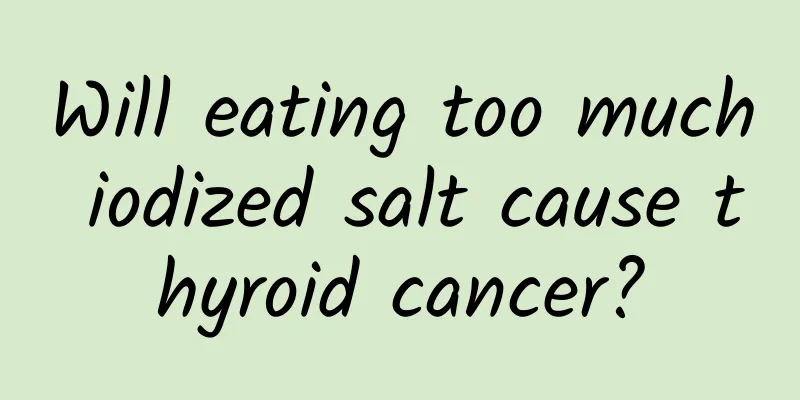Will eating too much iodized salt cause thyroid cancer?

|
Iodine is an essential micronutrient for metabolism and growth and development, and is the main raw material for the human body to synthesize thyroid hormones. Pregnant and lactating women need significantly more iodine than the general population. Iodine deficiency in pregnant women will cause iodine deficiency in the fetus, and iodine deficiency in the fetal and infant period will affect the normal development of the child's brain, and in severe cases cause cretinism (idiocy), deaf-muteness, intellectual impairment, etc. If pregnant women are severely iodine deficient, they will experience miscarriage, premature birth, stillbirth and congenital malformations. Iodine deficiency in adults may lead to hypothyroidism, fatigue, lack of concentration and decreased work efficiency. Iodizing salt is the most economical, effective and easy-to-implement measure to prevent and treat iodine deficiency. However, in recent years, there have been constant questions about whether the "high incidence" of thyroid diseases is caused by excessive iodine intake. Is there a relationship between thyroid disease and iodine intake levels? The project "Research on Iodine Nutrition Levels and Thyroid-Related Diseases in the Population" completed by the Zhejiang Provincial Center for Disease Control and Prevention clarified that the "high incidence" of thyroid nodules and thyroid diseases in the population of Zhejiang Province has no obvious relationship with iodine intake levels. In recent years, the incidence of thyroid cancer has been rising in major countries around the world, regardless of whether iodine supplementation measures have been taken. Studies have suggested that the current "epidemic" of thyroid cancer is mainly due to thyroid screening and is related to the diagnosis of occult cancer or microcancers caused by the widespread use of high-resolution B-ultrasound. An analysis of thyroid cancer cases treated in Zhejiang Cancer Hospital showed that from 2000 to 2014, a total of 10,111 thyroid cancer cases were treated, of which 3,242 were microcancers, accounting for 32.1%. In comparison, from 1986 to 1999, a total of 795 thyroid cancer cases were treated, of which only 3 were microcancers. The prevalence and multi-nodule rate of thyroid nodules increase with age and BMI (body mass index), and are more common in women. A considerable number of thyroid microcancers have the characteristics of indolent progression, low malignancy and good prognosis. How to identify thyroid nodules or goiters yourself The main symptoms include: foreign body sensation in the throat, difficulty swallowing, difficulty breathing, difficulty pronouncing or hoarseness, and pain caused by rapid enlargement of the nodule. If you have the above symptoms, it is recommended that you go to the hospital immediately for diagnosis through B-ultrasound or puncture. Depending on the condition, the attending physician will recommend different treatment methods such as follow-up, surgery, minimally invasive technology and iodine-131 treatment. How can different groups of people grasp the degree of iodine supplementation? First, let's popularize some knowledge about the iodine content of food, and rank them from high to low: ●Seaweed: kelp, laver, wakame, hair algae, etc. ●Iodized salt and chicken essence. ●Seashells and dried shrimps. ●Pickled foods: ham, salted fish, bacon, sausage, dried tofu or canned foods. ●Eggs: Mainly concentrated in the egg yolk, with quail eggs having a relatively high content, followed by chicken eggs, and duck eggs having a relatively low content. ●Others: Nuts. The higher the degree of processing, the higher the iodine content; meat, beans, and bean products. Special reminder: The iodine content in marine fish is the lowest among all seafoods. According to the World Health Organization's recommendation, the iodine intake standard for the population (the intake that needs to be guaranteed) is: 0-5 years old: 90 micrograms/day; 6-12 years old: 120 micrograms/day; >12 years old and healthy adults: 150 micrograms/day; pregnant and lactating women: 250 micrograms/day. Different groups of people have different iodine supplementation principles People who should avoid iodine: patients with hyperthyroidism and patients who need iodine-131 treatment. Because iodine is widely present in various foods, it is basically impossible to strictly follow an "iodine-free diet". So what we call "avoiding iodine" is to try your best to reduce iodine intake. For example: try to eat iodine-free salt and avoid eating out; do not eat pickled products and processed foods; do not eat seaweed, shellfish, shrimps, crabs; only eat egg whites; do not eat health products containing iodine. People with low iodine: Hashimoto's thyroiditis, people who do not need iodine 131 treatment after thyroid cancer surgery. Although people with low iodine do not need to control iodine intake as strictly as people who avoid iodine, they should try to eat less seaweed, and other foods can be eaten in moderation. Iodine-appropriate population: patients with simple thyroid nodules (normal thyroid function), patients after benign thyroid tumor surgery, and the general population can eat normally. Pregnant and lactating women should supplement high-iodine foods appropriately. |
>>: mNGS report is a blank, whose fault is it?
Recommend
Can I eat duck tongue during menstruation?
Nowadays, with the development of society, more a...
What medicine should I take for menopausal menstruation?
Excessive menstrual bleeding is actually a common...
Pregnant women should not drink garlic water
For pregnant women, they must have a reasonable d...
Do you know the side effects of propolis for women?
Propolis is a health food with extremely high nut...
How many days does it take for the menstrual period to come after taking progesterone?
Since corpus luteum copper regulates women's ...
What should I do if I don’t sleep well before my period?
Women may experience various physical discomforts...
What should women do if they have inflammation during menstruation?
As women, we all know that during the menstrual p...
To prevent cerebral infarction, you cannot just rely on folic acid supplementation, but also pay attention to these two diseases
A friend left a message to Huazi, asking how to s...
Can pregnant women eat arrowhead mushrooms?
Pregnant women can eat some water chestnuts appro...
Causes of breast pain after drinking soy milk
Soy milk is a drink that is loved by the public. ...
Can applying pearl powder, lemon, cucumber, etc. on the face whiten your skin? Beware of "bad face"! The correct whitening method is...
Author: Meng Yao, Ph.D., Doctor of Medicine, Zhon...
How many weeks of pregnancy is the progesterone test
Progesterone is a very special substance during p...
Which sanitary napkin is good?
Sanitary napkins are also called sanitary napkins...
Pre-pregnancy check-up must-do items
A pre-pregnancy physical examination is a compreh...
Medical abortion without fertilized egg implantation
Girls who have an unexpected pregnancy will have ...







![[Anatomist who knows sports] How dare you exercise without stretching?](/upload/images/67f19520a1b6c.webp)

